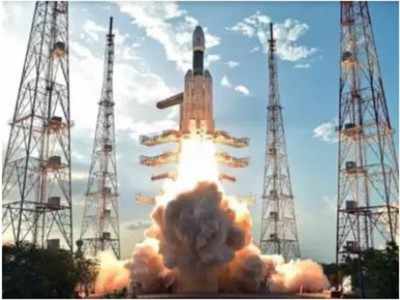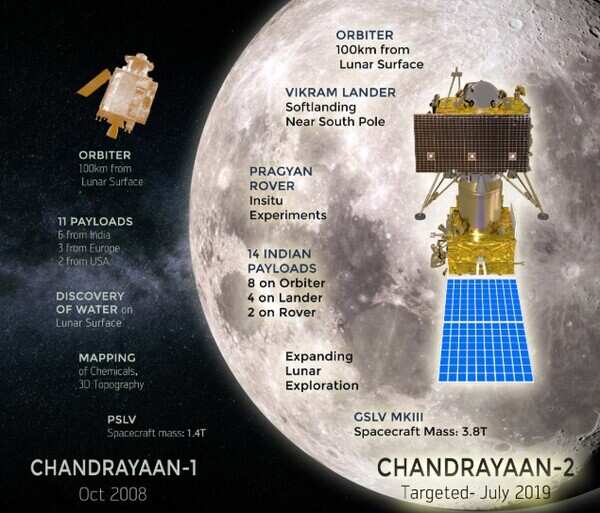- News
- India News
- Chandrayaan-2 will carry 14 payloads to moon, no foreign module this time
Trending
This story is from May 10, 2019
Chandrayaan-2 will carry 14 payloads to moon, no foreign module this time
Chandrayaan-2 mission involving a lander, a rover and an orbiter and whose launch is scheduled between July 9 and July 16 will carry 14 payloads. While the orbiter will carry eight payloads, the lander called Vikram will have four and the rover named Pragyan, which will roll out on the moon's surface, will have two payloads.

Image used for representation (File Photo)
Key Highlights
- Chandrayaan-2 mission involving a lander, a rover and an orbiter and whose launch is scheduled between July 9 and July 16 will carry 14 payloads
- While the orbiter will carry eight payloads, the lander called Vikram will have four and the rover named Pragyan, which will roll out on the moon's surface, will have two payloads
NEW DELHI: Chandrayaan-2 mission involving a lander, a rover and an orbiter and whose launch is scheduled between July 9 and July 16 will carry 14 payloads. These payloads or experimental modules will be used to perform scientific tests and take images of the moon when the spacecraft reaches the lunar orbit and subsequently the lunar surface. While the orbiter will carry eight payloads, the lander called Vikram will have four and the rover named Pragyan, which will roll out on the moon's surface, will have two payloads.
Chandrayaan-2 spacecraft, whose mass will be 3.8 tonne, is expected to land on the moon on September 6, an update in Isro website says. Unlike last time when Chandrayaan-1 mission, launched in 2008, carried five foreign payloads (three from Europe and two from the US), the Rs 800 crore second mission will carry only Indian payloads.
The orbiter and lander modules will be stacked as an integrated module and accommodated inside an advanced GSLV MK-III launch vehicle. The rover will be housed inside the lander. After the launch from Sriharikota into the earth-bound orbit by GSLV MK-III between July 9 and 16, the integrated module will reach the moon orbit using an orbiter propulsion module. After a journey from the earth to the moon in 45-50 days, the module will arrive in the lunar orbit, around 100 km from the moon's surface.

Talking to TOI earlier, Isro chairman K Sivan said, “Once Vikram lands on the lunar surface on September 6, rover Prayan will come out of it and roll out on the lunar surface for 300-400 metre. It will spend 14 earth days on the moon for carrying out different scientific experiments.” The rover will analyse the content of the lunar surface and send data and images back to the Earth through the orbiter within 15 minutes, he said.
The launch of India’s second lunar mission was initially planned in April last year but Isro kept deferring it because of the complexities involved in the mission. In fact, the four-legged Vikram lander suffered a fracture in one of its legs during a test earlier this year. India had also almost lost the race to Israel to become the fourth country in the world after Russia, US and China to land the spacecraft on the moon. However, with Israel’s Beresheet failing to land on the moon on April 12 this year, Chandrayaan-2’s moon-landing on September 6, if successful, will make India the fourth country in the world to land on the moon.
Chandrayaan-2 will explore the south pole, an uncharted territory. Only China’s Chang’e 4 spacecraft had recently in January landed on the moon’s far side, also known as the dark side because it faces away from the Earth and remains comparatively unknown.
India's first moon mission Chandrayaan-1, which involved only an orbiter and weighed 1.4 tonne, was launched on October 22, 2008. Then the lunar craft carried 11 payloads, six from India, three from Europe and two from the US.
The payloads in Chandrayaan-2 not only discovered water on the moon but also mapped 3D topography of the moon. The spacecraft made more than 3,400 orbits around the moon during which it took hundreds of images of the moon. The Rs 386-crore Chandrayaan-1 mission concluded when the communication with the spacecraft was lost on August 29, 2009. Chandrayaan-1 operated for 312 days as opposed to the intended two years but the mission achieved 95% of its planned objectives.
Chandrayaan-2 spacecraft, whose mass will be 3.8 tonne, is expected to land on the moon on September 6, an update in Isro website says. Unlike last time when Chandrayaan-1 mission, launched in 2008, carried five foreign payloads (three from Europe and two from the US), the Rs 800 crore second mission will carry only Indian payloads.
The orbiter and lander modules will be stacked as an integrated module and accommodated inside an advanced GSLV MK-III launch vehicle. The rover will be housed inside the lander. After the launch from Sriharikota into the earth-bound orbit by GSLV MK-III between July 9 and 16, the integrated module will reach the moon orbit using an orbiter propulsion module. After a journey from the earth to the moon in 45-50 days, the module will arrive in the lunar orbit, around 100 km from the moon's surface.

Once Chandrayaan-2 spacecraft reaches the lunar orbit, Vikram will separate from the orbiter and soft-land at the predetermined site close to the south pole, which had not been explored by other countries.
Talking to TOI earlier, Isro chairman K Sivan said, “Once Vikram lands on the lunar surface on September 6, rover Prayan will come out of it and roll out on the lunar surface for 300-400 metre. It will spend 14 earth days on the moon for carrying out different scientific experiments.” The rover will analyse the content of the lunar surface and send data and images back to the Earth through the orbiter within 15 minutes, he said.
The launch of India’s second lunar mission was initially planned in April last year but Isro kept deferring it because of the complexities involved in the mission. In fact, the four-legged Vikram lander suffered a fracture in one of its legs during a test earlier this year. India had also almost lost the race to Israel to become the fourth country in the world after Russia, US and China to land the spacecraft on the moon. However, with Israel’s Beresheet failing to land on the moon on April 12 this year, Chandrayaan-2’s moon-landing on September 6, if successful, will make India the fourth country in the world to land on the moon.
Chandrayaan-2 will explore the south pole, an uncharted territory. Only China’s Chang’e 4 spacecraft had recently in January landed on the moon’s far side, also known as the dark side because it faces away from the Earth and remains comparatively unknown.
India's first moon mission Chandrayaan-1, which involved only an orbiter and weighed 1.4 tonne, was launched on October 22, 2008. Then the lunar craft carried 11 payloads, six from India, three from Europe and two from the US.
The payloads in Chandrayaan-2 not only discovered water on the moon but also mapped 3D topography of the moon. The spacecraft made more than 3,400 orbits around the moon during which it took hundreds of images of the moon. The Rs 386-crore Chandrayaan-1 mission concluded when the communication with the spacecraft was lost on August 29, 2009. Chandrayaan-1 operated for 312 days as opposed to the intended two years but the mission achieved 95% of its planned objectives.
End of Article
FOLLOW US ON SOCIAL MEDIA










